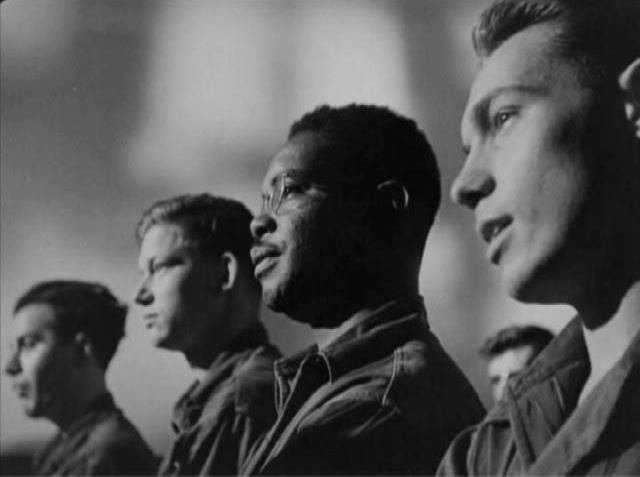Let’s begin this online viewing tip with Noel Murray at the AV Club: “Novelist, reporter, screenwriter, and critic James Agee spent much of the ’40s picking through the output of Hollywood studios, seizing on anything clever or mature, and championing any writer or director who seemed willing to sneak some art into the mass media. Agee was especially taken with the work done by Hollywood filmmakers on behalf of the US government during World War II, seeing these clear-eyed, straightforward, passionate documentaries as an example of ‘what men of talent, skill, and courage can do if even one hand is untied from behind their backs.’ But the government wasn’t always as impressed as Agee. They censored some of the films Agee praised in his columns for Time and The Nation, and completely shelved John Huston’s Let There Be Light, which Agee aptly described as ‘a fine, terrible, valuable non-fiction film about psychoneurotic soldiers.’ Whenever he found an opportunity, Agee reminded his readers about the fate of Let There Be Light, telling them that a movie paid for with tax dollars was gathering dust.”
“Suppressed for over thirty years, Let There Be Light has never received the attention it deserves as one of the most moving and honest of wartime documentaries,” writes Daniel Eagan for Smithsonian Magazine. “A new restoration undertaken by the National Archives and Records Administration and hosted on the National Film Preservation Foundation’s website may help bring this John Huston film to a wider audience. With help from Fandor.com, the NFPF is making this restoration available online from now until August 31, 2012. I’ve written about Let There Be Light before, on this blog and in my book about the National Film Registry. I also contributed to Sara Fishko‘s recent piece about the film for WNYC radio. I relied on the available prints: scratched, dupey 16mm copies with muffled soundtracks and frequent splices. The restored version makes it clear that Huston was among the best documentarians of his time.”
“The subject of Let There Be Light is what we’d now label PTSD—post-traumatic stress disorder—among returning soldiers,” explains the NFPF, “and if the term is of more recent invention than Huston’s film, that’s in good part precisely because such sympathetic examinations of the condition were swept under the rug until after the Vietnam era. What World War II soldiers still called ‘shell-shock’ was variously labeled ‘psychoneurosis’ or ‘neuropsychosis’ by physicians, and it was under the working title of The Returning Psychoneurotics that the assignment was given in June 1945 to Huston, then a major in the Army’s Signal Corps. He later described how he went about the project.” See the site for that description.
“In the end,” wrote Kent Jones for Reverse Shot in 2003, “this is a movie best understood as an artifact of that brief postwar moment when Hollywood wrestled with the truth, when the urge to cosmeticize was, for an ever-so-brief moment, automatically questioned and even resisted. Just as in fiction films of the period like From This Day Forward, Till the End of Time, and, of course, The Best Years of Our Lives, there is a conflict between duty to country and duty to reality, and between the re-touched and the unvarnished…. There are key moments in Huston’s film that tell the beginnings of the story Terence Malick would finally finish, so many years later, with The Thin Red Line. Movies that show ‘the horror of war’ have a much easier task than those that attempt to show its after-effects: they take place in high-pressure, instantly dramatic arenas, in which terror finds an objective correlative in the violence of warfare. Much more difficult to show is the internal damage, the psychic shattering, splintering, as it affects day-to-day existence. As Huston’s moving camera-eye surveys the faces of soldiers during the intake scene and records their words, the dark, quiet sobriety is overwhelming.”
Marilyn Ferdinand: “For those who took an interest in our recently completed blogathon to stream the Cutts/Hitchcock film The White Shadow, the online presentation of Let There Be Light is a preview of the high-quality streaming, expert research, and copious film notes we can expect when that silent film makes its debut. For Let There Be Light is an amazingly powerful experience, even on my laptop, and one that left me in tears by its conclusion.”
More from Kenneth Turan (Los Angeles Times) and Steve Vogel (Washington Post).
For news and tips throughout the day every day, follow @KeyframeDaily on Twitter and/or the RSS feed. Get Keyframe Daily in your inbox by signing in at fandor.com/daily.





